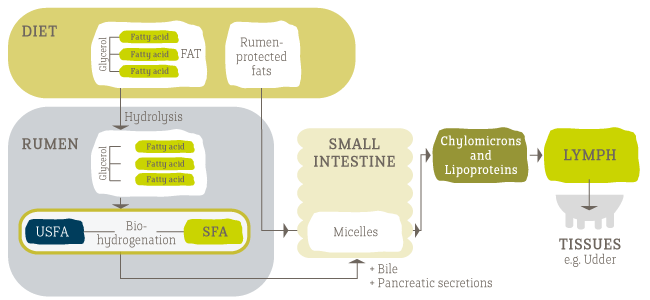Fat digestibility - ruminants
Nutrients are only useful to an animal if they can be digested and absorbed, otherwise they pass through the digestive tract and are lost in the faeces. The energy value of a fat supplement is dependent primarily on the digestibility of the fatty acids, which can vary dramatically between different types or sources of fat.
Most fats in animal feedstuffs are present as triglycerides or, in the case of forages, as glycolipids where one of the fatty acids is replaced by sugar. An overview of fat digestion in ruminants in presented in Figure 1.
The first stage of fat digestion occurs in the rumen where bacteria split off the individual fatty acids (and sugars) from glycerol by the process of hydrolysis, with typically >85% of glycerides undergoing hydrolysis. The unsaturated free fatty acids released are extensively biohydrogenated and converted to saturated fatty acids, the latter consisting of about ⅓ palmitic and ⅔ stearic acids.
The free fatty acids then pass out of the rumen attached to feed particles (80-90%) and enter the small intestine where, with the addition of bile and pancreatic secretions, they form structures called micelles. Formation of micelles is the key to fat digestion as this is the form in which the water-insoluble fatty acids are absorbed through the gut wall. Here they are converted back to triglycerides and packaged into chylomicrons and lipoproteins, before entering the lymphatic system for delivery to tissues for use as energy source, milk fat, or body fat deposition. Absorption of fatty acids occurs predominantly in the jejunum region of the small intestine.
Rumen-protected fats pass through the rumen unaltered for digestion in the small intestine.

Figure 1 Major processes involved in digestion of fat in ruminants
Highly-saturated triglycerides can have poor digestibility due to their high melting points and low solubility preventing digestive enzymes from breaking them down. Hence, fat supplements based on saturated triglycerides typically have lower digestibility than other fat supplements with hydrolysis of the triglycerides in the rumen considered the rate limiting step.